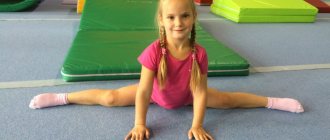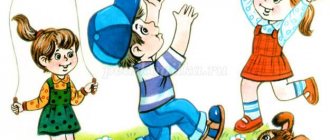Card index of didactic games for older children on the topic “Health and healthy lifestyle”
Card index of didactic games for older children on the topic
"Health and healthy lifestyle"
1. Didactic game “Healthy Baby”
Goal: to introduce children to the rules of personal hygiene and a correct, careful attitude towards their health.
Rules of the game.
The presenter distributes large cards to the children and shows small ones
cards. The one who has this card explains “whether this is good or bad.”
The one who fills out their big card the fastest wins.
2. Didactic game “Dress the kids for a walk.”
Objectives: to develop the ability to distinguish items of clothing depending on the time of year; develop fine motor skills of the hands. Develop grammatically correct speech.
Material: figures of a boy and a girl made of cardboard, paper clothes.
Description: Option 1. The presenter sets the season, and the players dress the child figures in appropriate clothes. The presenter checks the correctness of the task and, in case of errors, corrects them, explaining his actions.
Option 2. The children themselves agree among themselves what season the figures will wear. After completing the task, they explain their choice of clothing.
3. Didactic game “What comes first - what comes next (daily routine)”
Objectives: to reinforce the idea that following the correct daily routine is good for health. Develop the ability to coherently and consistently explain your actions.
Material: plot pictures depicting actions characteristic of a certain period of the day.
Description: invite the child to arrange the pictures in the correct sequence and explain his choice.
4. Didactic game “Health Labyrinths”.
Objectives: to consolidate knowledge about personal hygiene items and their purpose. Teach children to see the boundaries of the drawing (in this case, paths, draw lines without lifting your finger from the picture; develop thinking, logic, eye, perseverance, will; teach them to embrace the entire picture, mentally build a “travel” route.
Material: cards with images of labyrinths.
Description: the child is given the task of finding the way from a personal hygiene item to the part of the body for which it is intended. Explain how and why this item is used.
5. Didactic game “Harmful - Useful.”
Objectives: to form ideas about preventive and health measures. Develop visual perception, voluntary attention, logical thinking, grammatically correct speech.
Material: paired cards opposite in meaning to health, picture chips depicting actions that are harmful or beneficial in a given situation.
Description: Option 1. The child is asked to look at the pictures and determine: which of them depict actions that are harmful to human health, and which, on the contrary, are useful.
Didactic outdoor games for preschoolers Healthy Lifestyle Lifestyle
Didactic outdoor games to consolidate preschool children’s knowledge of healthy lifestyle and lifestyle
SEE ALSO Lesson summary on the topic of introducing children to a healthy lifestyle Memo on developing healthy lifestyle habits Didactic games on valeology Lapbook “Book of Health”
Dangerous-safe
Objectives To teach children to determine the degree of dangerous behavior in everyday life and to make the right decisions. Progress of the game The playing area is divided into two zones: yellow and red (dangerous-safe). Children walk scattered around the playground. At a signal, the children stop, the instructor names everyday situations, the children move to the danger zone according to their ideas, and if necessary, the situations are discussed.
- I play ball on the roadway
- I cross the road in the wrong place
- I play in the sandbox on the playground
- I use someone else's comb
- I use someone else's handkerchief
- I left the site with a stranger
- I cross the road at a pedestrian crossing, etc.
Talking body
Objectives Consolidate children's knowledge about body parts, develop coordination of movements.
Progress of the game Children stand in a semicircle. The instructor calls the kids one by one and gives them a task, for example:
- say yes with your head
- say with your foot that you are unhappy
- say with your hand "come here"
- say “thank you” with your body
- say “I don’t know” with your shoulders, etc.
All children repeat the movement shown, guess what the body is saying
Kinds of sports
Objectives To develop the ability to act together, to consolidate knowledge about sports. Progress of the game Children are divided into two teams, a competition is held
- jumping from hoop to hoop
- crawling on your stomach, pulling yourself up with your arms
- crawling under an arch
- run to the cube, take a card (one team has cards with winter sports, the other with summer sports), run back to the team
The team that wins the competition starts the game: using the pictures, the children conspire and pantomime show the sport, the opponents guess. Then it’s the second team’s turn.
Chain
Task Develop memory, attention, develop communication skills Progress of the game Children are given a topic in advance, for example, “Daily routine.” Children line up in a line. The instructor with a large ball gets up first, begins the story and passes the ball to the next child, “In the morning I woke up early...”, the child continues, for example, “I washed my face,” passes the ball to the next, etc. Themes for the game: “We need to cook soup”, “We are going for a walk”
About hygiene rules
Objectives : Develop healthy habits and reinforce hygiene rules. Progress of the game Children stand in a circle, one child in the center, depicting an arrow, spins around himself, the children say “Stop!”, at whom the hand pointed - the arrow answers the instructor’s question with a pantomime, all the children repeat the movements after him
- what do you do when you wake up in the morning
- how do you wash your face
- how do you brush your teeth
- how do you comb your hair
- how do you do gymnastics
- what do you do before eating, etc.
A variant of the game with older preschoolers: children show what they are doing without leading questions, children guess and show how they do it.
Like in the mirror
Task: To teach to coordinate movements. Progress of the game Children line up in two lines opposite each other, forming pairs. First, one of the pair shows the movement, and the second tries to mirror it, then the second shows his movement.
Line up
Task To teach joint actions using non-verbal means of communication. Progress of the game The game is played to the music. Children walk scattered around the hall, the music stops, the instructor gives different commands:
- line up according to height
- line up first boys, then girls
- line up first girls, then boys
- build through one boy - girl
- build first with dark hair then with light hair
- build first with long hair, then with short
- line up along the length of shorts, etc.
True or false
Objectives: Consolidate knowledge on the topic of health, develop coordination. Progress of the game The presenter - the instructor in the role of a doctor - asks questions, and the guys react to them with conventional gestures, for example, if it’s true, then they jump, if it’s not true, they stomp their feet. Questions:
- It's true that adults don't get sick
- Is it true that you should wash your hands before eating?
- Is it true that you can walk without a hat in winter?
- Is it true that by sneezing on your neighbor you can infect him
- It is true that those who do not ventilate the room become healthier, etc.
Artist
Objectives Consolidating knowledge on the topic of a healthy lifestyle, developing speed and dexterity Progress of the game Children stand in a circle. The leader chosen by the counting rhyme “draws” on the back of the person standing next to one of the household items: a comb, a toothbrush, a towel, a washcloth, a cup, a fork..., the player must guess the item and show the action with this item, all children guess the item and name it if the player managed to correctly show what was drawn, he becomes an artist, if not, the stick is placed between the players, the children run in a circle in different directions, trying to be the first to take the stick. Whoever manages to take the stick first continues the game.
How didactic games are conducted in the middle group
Games should not be too simple, as this will cause boredom and reluctance to practice. But you shouldn’t make classes too complicated. Questions and assignments must correspond to the developmental characteristics of a given period of life. This will help stimulate the desire to learn new things and achieve visible results.
How to create a motivating environment
At the age of 3-5 years, children react with great interest to fairy tales and magical manifestations. Any activity can be carried out in the form of fairy-tale adventures, meetings with animated heroes, or travel to a magical land.
We must not forget! Excessive mobility is another distinctive feature of this age. You cannot abuse the child’s attention and delay intellectual work. Be sure to alternate sedentary activities that require increased concentration with outdoor games.
Didactic games for the middle group
Through play, children become familiar with the world around them and develop good habits and concepts. During the didactic game, adults teach four-year-old children to engage in joint cognitive activities.
Peculiarities
A child aged 4-5 years is distinguished by an inexhaustible supply of curiosity and a desire to get answers to many questions that interest him. It is at this age that a significant growth in the baby’s abilities is manifested. According to the observations of psychologists, thinking during this period becomes more imaginative, and the psyche is more stable compared to previous years of life.
Differences
In the middle group, object games fade into the background, although they still remain relevant. To a greater extent, they are aimed at consolidating familiar concepts.
They are gradually being replaced by board-printed and word games. During this period, the active formation of FEMP* begins.
Math lesson
Homemade games for children in the middle group
Manufacturers of children's goods offer an increasingly diverse range of games and toys for early development. However, it is not necessary to use only purchased teaching materials. In many cases, homemade games and add-ons to store-bought sets may be suitable.
The teacher should not completely take upon himself all the hassle associated with the production of the elements necessary for the game. His task is to identify the goal and convey it to the parents. Conversations should emphasize the importance of their participation in the life of the group.
Note! Items made by mother's or father's hands are of great importance for any child and help his socialization among his peers.
Making educational games with your own hands
Parents can make elements that bring children's play closer to reality.
- Sew clothes and bed linen for the doll corner. Help in making masks for theatrical activities.
- To maintain interest in toys, some of the available games should be removed from the free access area into drawers and boxes covered with the same self-adhesive paper. It is convenient to use games in which small parts are not mixed together, but are placed in bags specially sewn for them. Parents can easily help decorate toy containers beautifully.
- The Seasons Corner is an important teaching material for which exhibits cannot be purchased. But natural materials and hand-made crafts are excellent for use.
Corner of the seasons
- The demonstration material will also be useful for studying local history. The teacher is unlikely to be able to purchase ready-to-use sets on the topics “My City”, “My Republic”, etc. Most likely, a card index is best suited for such activities, the pictures for which will be specially selected and printed.
Conducting games for middle group children
Starting from the middle group, a child attending kindergarten is engaged in activities aimed at his personal development.
Lesson in kindergarten
Didactic games for preschool age in preschool educational institutions
Along with tasks in mathematics and speech development, children have the opportunity to learn to draw and sculpt in creative art classes. An important feature of such activities should be a frequent change of activity, in which children have the opportunity to alternate sedentary intellectual activities with active games and physical exercises.
Important to remember! A well-planned educational process will avoid overwork, will not cause boredom and will help to achieve the highest possible results.
Finger drawing technique
Goals and objectives of gaming activities in the middle group
A 4-5 year old child must have certain skills and concepts. At this age, the main activity is play. That is why it is important to adhere to a playful form of learning, which will influence the formation of qualities and skills necessary for the development of attention and thinking:
- presence of an active vocabulary;
- the ability to express thoughts using coherent speech;
- ability to distinguish and describe objects (shape, color, size);
- understanding of numbers and quantity;
- the desire to compare and generalize concepts or objects;
- strengthening abilities aimed at concentrating;
- memory development.
Important point! A game activity should help consolidate what has been learned and at the same time serve as an impulse that encourages children to learn about topics that are new to them.







